home
Ditko's role in creating Spider-Man
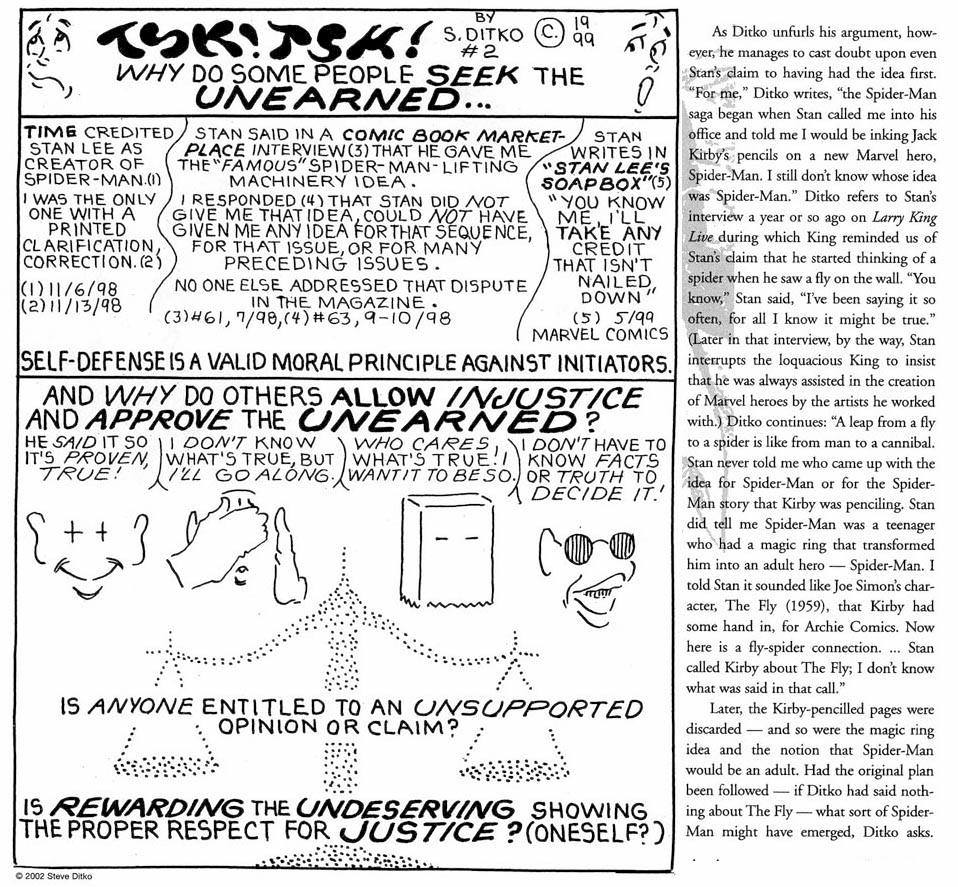
Patrick Ford
October 19, 2017
STEVE DITKO: "He Giveth and He Taketh Away"
STAN LEE: "I just mentioned the idea, but Steve drew in incredibly. ... I'm still Steve's biggest fan."
In COMIC BOOK MARKETPLACE #61 Stan Lee took credit for lifting sequence in AMAZING SPIDER-MAN #33. Lee said he had only mentioned the idea to Ditko and hadn't anticipated Ditko devoting several pages to it. Ditko disputed Lee's claim in a letter published by COMIC BOOK MARKETPLACE #63 as well as in several of his later essays concerning Stan Lee.
Ditko only quoted a portion of Lee's claim in his replies. Lee's claim, which I quoted above, had a tail end to it which many fans would be familiar with.
George Hall
The printed bit...now that really does clarify a few thinks...Ditko actually admitting there he had NOT necessarily seen what Jack came up with first, but only went by what Stan had said. Ditko there has contradicted what he said in other places.
Patrick Ford
Ditko has been clear he saw Kirby's five pages. Lee was handing them over for Ditko to ink when Ditko told Lee they reminded him of The Fly.
I think what he's describing here is Lee never telling him who came up with the idea for a Spider-Man and whose story ideas were represented in Kirby's five pages. Then when Ditko actually saw the pages he recognized them as a variation on The Fly.
My assumption is there was one conversation where Lee mentioned Spider-Man without going into much detail. During that conversation Lee told Ditko that Martin Goodman wanted a whole line of insect based characters. This resulted in Spider-Man, Ant-Man and a planned Bee-Man.
Lee would not have been able to tell Ditko what was in Kirby's five pages because Lee probably hadn't seen them yet when he first mentioned this plan to Ditko.
Patrick Ford
Note that as is typical Lee first takes credit for something created by Ditko and then adds, "I'm still Steve's biggest fan." Ditko does not fall for this sort of ruse, "The right hand drawing back as the left hand advances. "
Patrick Ford
In a 2012 essay titled "The Silent Self-Deceivers" Ditko takes Marvel and fans to task for ignoring the obvious contradictions between the Kirby Spider-Man pages seen by Ditko and Lee's claim that he gave a Spider-Man character to Kirby. Among other things Ditko points out Lee's decision to run Kirby's covers on the first two Spider-Man comic books (AF #15, ASM #1) contradicts Lee's claim that Lee did not want a typical muscular Kirby super hero.
Patrick Ford
Ditko mentions he does not know whether or not the plot for AF #15 came from Kirby or Lee. He only knows that Lee said he was going to speak to Kirby. Stan Taylor and others have pointed out a number of Kirby tells in that story. The similarity to the origin of the Rawhide Kid, the chapter breaks, elements taken from The Double-Life of Private Strong.
There are also Kirby elements in ASM #1. Ditko frequently points out that while he does not know if those ideas came to Lee from Kirby.
Michael Hill
Jean Depelley points out a rather obvious swipe in ASM #1, the fight scene, condensed from a longer Kirby fight scene that would appear in FF Annual #1, in a story that happens to match Kirby's ASM #1 cover. The swipe was by Ditko or Brodsky. Depelley speculates that Lee commissioned stories from Ditko *and* Kirby for successive issues of Amazing Fantasy, putting paid to the lie that the title was about to be cancelled.
Mark Mayerson
Has anyone ever explained the time gap between Amazing Fantasy 15 and Spider-man 1? When Thor, Dr. Strange, Iron Man, and Ant Man started in the old monster magazines, they kept the titles going under the same name.
Patrick Ford
Will Murray's idea is the title was cancelled due to poor sales on AF #14. When Goodman got reports on the sales of AF #15 he gave Spider-Man his own title. Murray uses job number to make a sound case the complete contents of what was supposed to be AF #16 were completed. The Spider-Man story was the "Terrible Tinkerer" story which eventually ran in ASM #1. The two Ditko fantasy stories which would have completed AF #16 (based on job numbers) ran in JOURNEY INTO MYSTERY #83 and STRANGE TALES #100.
Mark Mayerson
That may be true, but you would think that since Amazing Fantasy 15 took the magazine in a new direction, it would make sense to give it another few issues and see if it made a sales difference. Especially since material for Amazing Fantasy 16 already existed.
Patrick Ford
Patrick Ford Mark, True but I suppose in Goodman's eyes the whole comics division was still on thin ice. I don't have any idea how well the FF was doing, but the second hero title introduced was the HULK which failed. So perhaps Goodman was by no means sold of the idea super heroes were going to save the company.
Patrick Ford
Another thing I've wondered about is if Kirby's "The Bug" was a play on his original Spider-Man costume.
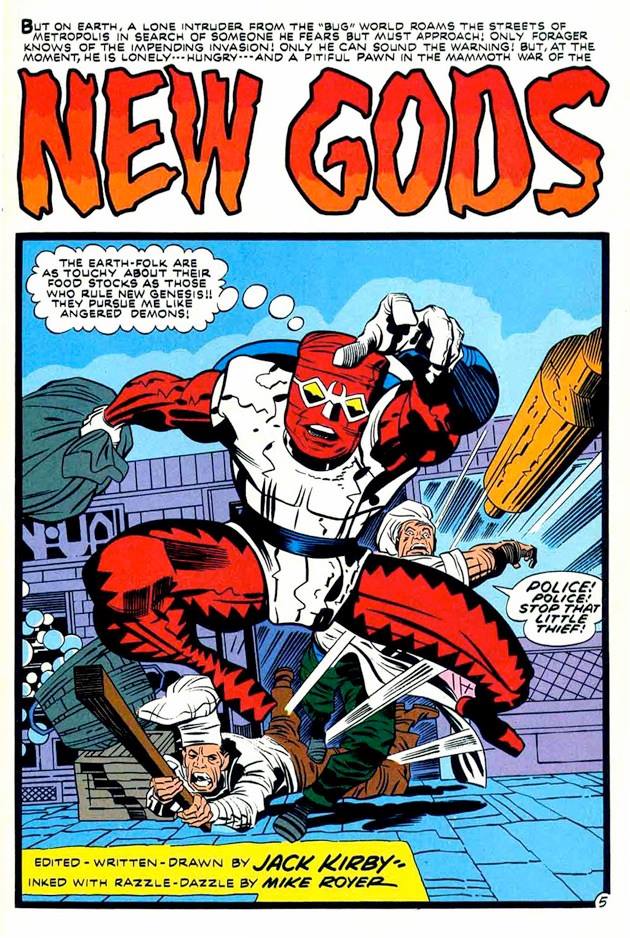
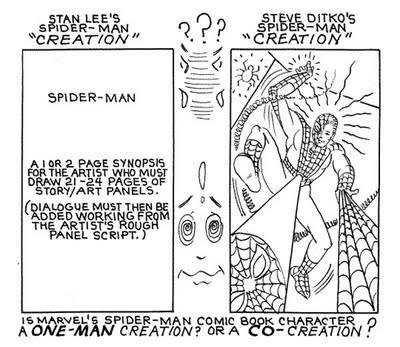
J David Spurlock
7 August 2016
Steve Ditko, in his 1990 piece, “An Insider’s Part of Comics History"
confirmed that Stan Lee provided him a 1-to-2-page synopsis for the
first appearance of Spider-Man (Amazing Fantasy #15). Ditko confirmed
elsewhere that, before long, he was plotting Spider-Man on his own,
without any input from Stan. After months of debate, Ditko finally
started getting plot credit with Amazing Spider-Man #24.
Patrick Ford: Ditko began getting plot credit with issue #24. Ditko
mentions that "even before" he began getting plot credit Lee had
decided to stop speaking to Ditko. Lee would not even come out of his
office when Ditko dropped off his pages. Ditko has also written that
he strongly disliked it when characters (villains or heroes) crossed
over into the Spider-Man book. The last crossover in SPIDER-MAN was
issue #21 which featured two crossovers, the Human Torch and the
Beetle. So it is likely Ditko began plotting alone as of issue #22.
That said Ditko makes clear in his essays that the synopsis supplied
by Lee always came after a story conference. And Ditko's detailed
descriptions of those story conferences describe a tortured sounding
process where Ditko spent a lot of time rejecting any ideas Lee
proposed.
Dave Rawlins: Of course we know that the synopsis Lee presented Ditko
must have come after the 5 pages Kirby turned in that Ditko said were
similar to The Fly.
Patrick Ford: A fact not in dispute. What is disputed is Lee does not
acknowledge that Kirby's Spider-Man was a variation on The Fly. When
questioned under oath if the Kirby pages were based on The Fly Lee
said they were not. So Lee's claim is Kirby worked from the same
synopsis Ditko worked from, thus the "too heroic looking" claim Lee
gives for having rejected Kirby's pages. A teen using a magic ring to
transform into an adult hero would not fit a "too heroic looking"
claim because an adult hero would naturally not be scrawny. Ditko and
Kirby have both pointed out this contradiction. Despite that fans and
historians have failed to ever notice that Lee has never acknowledged
the Kirby Spider-Man based on The Fly.
Patrick Ford: BTW. The one Spider-Man synopsis not based on a story
conference with Ditko is the synopsis for the AF #15 story.
In that case Ditko has written Lee told Ditko that Lee was going to
speak to Kirby. After speaking to Kirby Lee gave Ditko the synopsis
for AF #15. That story bears strong resemblance to two other stories
by Kirby. The origin of the Rawhide Kid and the origin of Private
Strong. Ditko wrote that he had no idea if the ideas in the synopsis
were Kirby's or Lee's.
Ditko had the ideas, and Lee merely edited
Patrick Ford
December 2, 2017
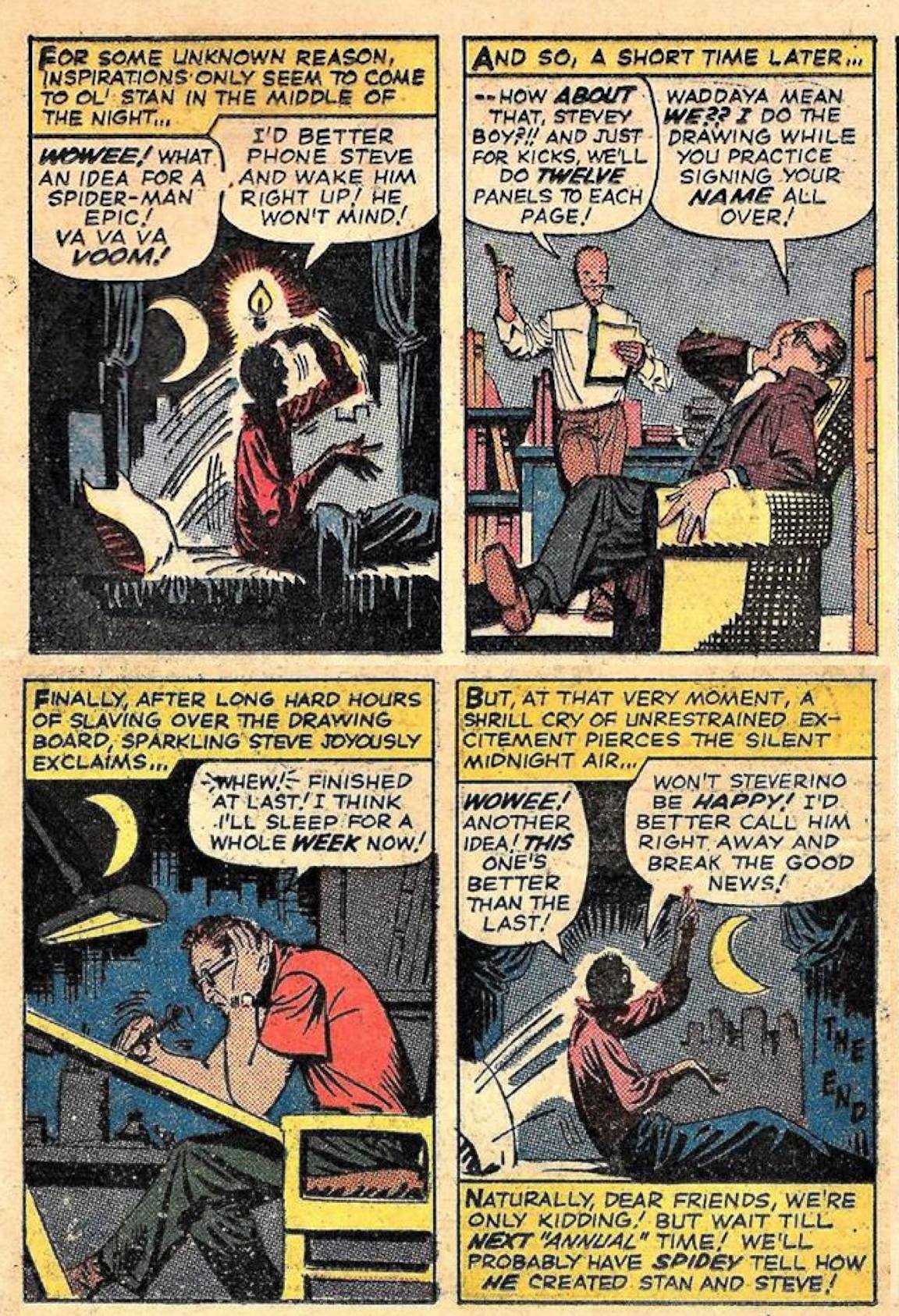
AMAZING SPIDER-MAN ANNUAL #1 contains one of several short humor features which ran in various annuals in 1965-1966. Lee used these to mildly poke fun at the Marvel Method and the part he played in the production of the stories. Still Lee could not resist depicting himself as the "idea man" as seen in these four panels Lee has written the dialogue and captions to show himself waking up in bed with an idea while the art clearly was drawn by Ditko to show himself waking up in the middle of the night with the ideas. The awaking figure is even drawn wearing glasses although Lee added a dot to the glasses so they would read as an eye.
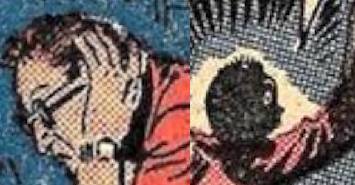
When drawing an open eye in profile Ditko always used a triangular shape. Never an elliptical one.

Patrick Ford
Aside from the mid-town setting (Lee lived on a large estate on Long Island) and the glasses it's evident the awaking character has a thick swept back head of hair which stands up well above the skull where as Lee was essentially bald at the time.
Lee praised for balloon placement
7 August 2016
Michael Hill: There's a bona fide pro commenting on this thread at
Ditkomania, talking about how Lee is the most brilliant writer who
ever lived and how great it was to work with him. I don't think I've
ever seen a less appropriate place to state regarding Ditko's essays
that "there are two sides to every story." Over to you, Dave, I've
blocked him.
Dave Rawlins: I could tell Lee where he can place his balloons!
Patrick Ford: The balloon placement business is directly from Roy
Thomas who mentions Lee's balloon placements every chance he gets as
if balloon placement is high art.
There is judgment involved in balloon placement. Michael Royer has
talked about this. Lee just happened to be really lousy at it and the
fact that fans of Marvel have picked up on Roy Thomas' nonsense is to
be expected.
Patrick Ford: Roy Thomas' delusions:

Patrick Ford: As far as I've ever noticed Lee's balloon placements are
some of the worst I have ever seen.
Dave Rawlins: Yes, it's an art. For instance, the balloon should not
cover the speaker's face. And it is preferable to have the pointer
directed toward the heads of speakers rather than their butts and
crotches.
Patrick Ford: Stan Lee: Speech balloon placing genius.
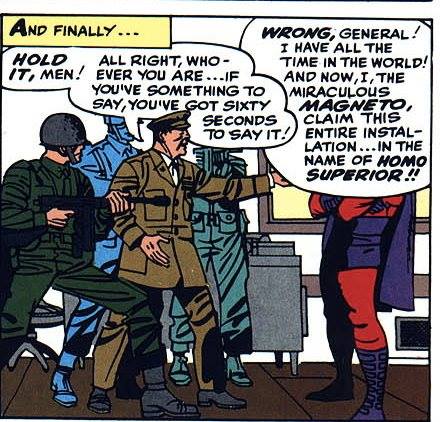
Dave Rawlins: Lol!
Patrick Ford: One good thing did come out of that post at Ditkomania.
A LOC page plot credit for Ditko on issue #18 of ASM.

Patrick Ford: BTW. ASM #18 does feature a Fantastic Four crossover
which is something Ditko would never do unless Lee ordered it.
This indicates to me that Lee's involvement in issue #18 was basically
the same as it had been since the first issue of ASM.
Based on Ditko's essays the story conferences with Lee were basically
comprised of Lee suggesting ridiculous ideas that Ditko shot down and
Lee ordering crossovers.
It's far more likely that the credit in the ASM #17 LOC was prompted
by a confrontation between Lee and Ditko than it is evidence of Ditko
doing anything out of the ordinary.
Dave Rawlins: Yep. I don't think Lee's suggestions amount to anything
resembling a bona-fide plot. Ditko carried the show throughout his
run.
Patrick Ford: Ditko has actually been very reserved in his comments on
Lee's "plotting." If a reader of the essays pays attention they will
notice that Ditko describes Lee's "plots" as things like, "Let's do a
Spider-Woman, Let's have Attuma fight Spider-Man. Even when Ditko did
not completely reject a Lee suggestion Ditko would so completely
transform Lee's "idea" that all that remained would be the name. A
good example of that is The Green Goblin.
Dave Rawlins: Here's something I posted to the Ditkomania thread, a
letter from ASM#50 in which a fan posits that the book had gone
downhill after Ditko's departure. Someone chimed in the opinion that
printing critical letters was detrimental, so I pointed out that
Kirby's 70s comics were loaded with criticisms of his work. Then the
guy says criticism is ok now and then. These true believers can't help
but wanting it both ways! Here's the letter from ASM #50, which
ironically had a retread of Ditko's ASM #18 plot.
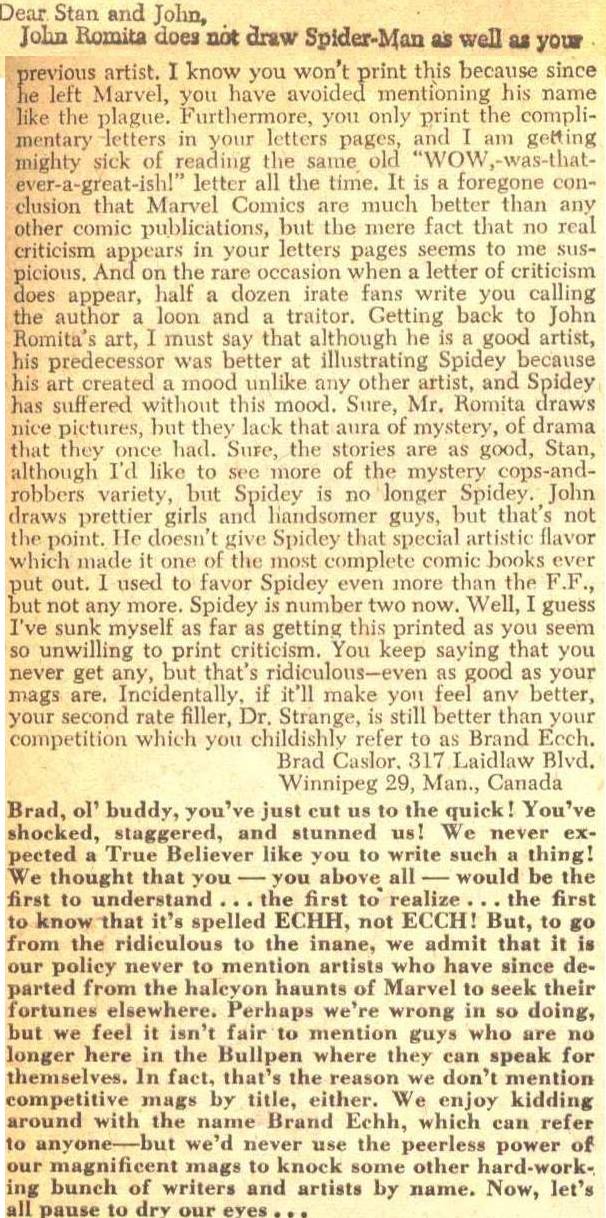
Patrick Ford: That guy commenting at Ditkomania is a perfectly typical
example of a Stan Lee advocate. I'm sure you noticed he claimed the
Kirby LOC pages were balanced. Proportionally there are positive and
negative letters but the guy turned his original argument on it's
heel. This is the problem with fans of Lee. One moment they will say
"Stan will never invade the Ukraine." When it is pointed out to them
that Stan is in the Ukraine they immediately say that Stan would not
be in the Ukraine if Ditko hadn't been there first.
Patrick Ford: When people completely change their positions and just
make stuff up as they go along it becomes a waste of time to discuss
anything with them. The best thing to do is keep right on commenting
and just ignore anything they say.
Dave Rawlins: Indeed, if Stan gunned down a pedestrian on Broadway
during rush hour his True Believers would excuse him. Sorta' sounds
like the supporters of the Orange One, does it not?
Patrick Ford: Excuse him? They'd cheer him on.
Dave Rawlins: The man is a genius at bullet placement!
Patrick Ford: Just in case anyone is interested Dave posted the
negative letter published in ASM #50 and Dave added that he suspected
there were more letters like it but was not surprised there were not
more letters like it that were published.
Then a True Believer commented that comic books do not publish
negative letters because they are harmful.
Dave pointed out the LOC pages on KIrby's '70s era books contained
numerous negative letters.
The guy countered this by saying the LOC pages also contained positive letters.
Dave Rawlins: Like I said, they want to have it both ways. When Lee
hogs credit, it's ok with them. When Kirby, Ditko and Wood speak up
about what they actually did, they're, "tearing Lee down to build
themselves up".
Dave Rawlins: And if one happens to give creedence to the accounts
Lee's "artists" report they've drunk the "kool-aid".
Patrick Ford: I've tried every approach imaginable in trying to have a
sensible discussion with these kind of people and it's hopeless. Even
if you patiently try to reply to every error they make in their
arguments it will always end with them becoming angry. When they
figure out they are in over their head their usual recourse is to
begin attacking the messenger.
Dave Rawlins: I don't entertain the notion that such individuals are
open to persuasion, rather it's those lurkers who are reading that I
aim to reach.
Patrick Ford: Check the ASM #32 LOC page.
"No need for a big ballyhoo about our next ish. It's scripted by Stan
and drawn by Steve."
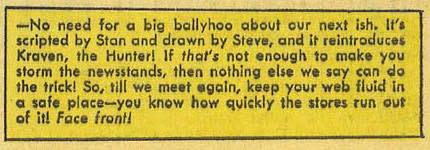
J David Spurlock: Obviously, Stan did tons of diologue and I don't
doubt he had to come up with plots for less versitile pencilers but,
so much of what artists have given as examples of Stan's plot
contributions are actually, as Jack considered them, simply editorial
direction -- some of which, including every crossover are marketing
oriented -- as opposed to actual plots. In contrast, Julie Schwartz
often contributed much more but never considered putting in for
co-writer pay or credit.
Patrick Ford: Not only that J David but there are numerous accounts of
Lee having absolutely nothing to offer. That includes not only Kirby,
Ditko, Wood, but Orlando and even Lee's close friends Stan Goldberg
and Richard Ayers.
J David Spurlock: And Romita
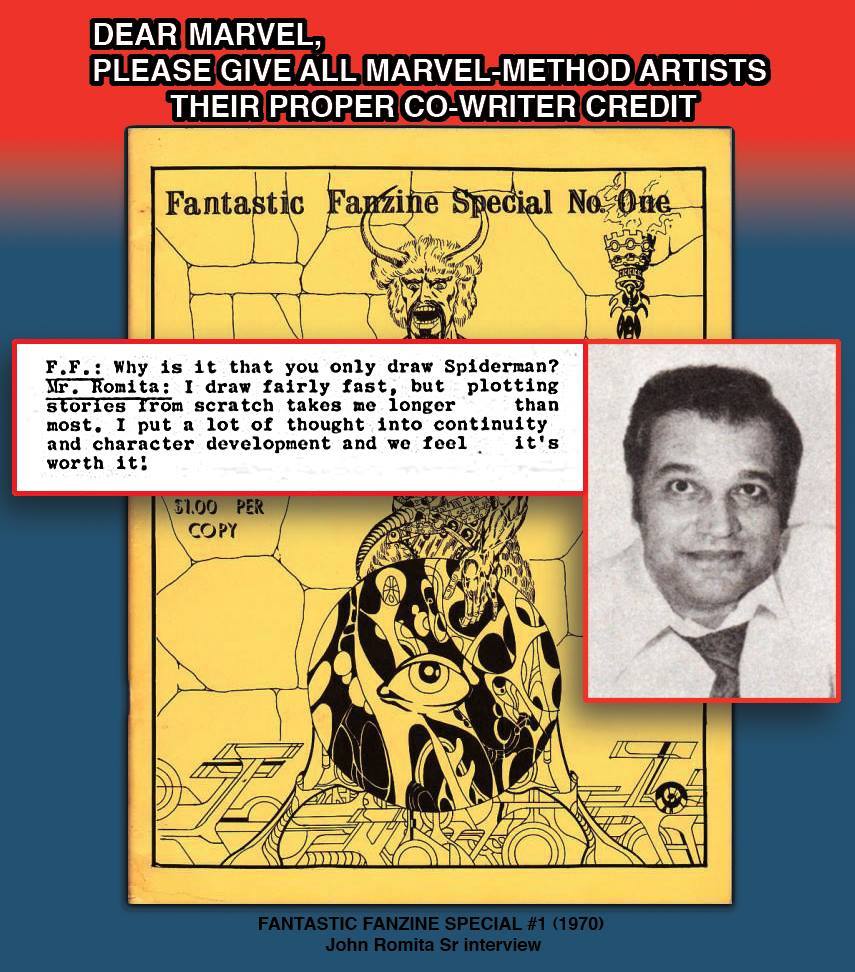
Patrick Ford: And none of these people are Kirby. Not even Wood or
Ditko are known to be the human plot Rolodex that Kirby was always
known as. It defies all logic that Lee would plot for Kirby (or even
suggest a little plot springboard) when Lee was telling people like
Ayers and Goldberg that they had better come up with a plot because
Lee did not have one. And that goes right down to something as simple
as "Millie gets a hair cut." Which came from Stan Goldberg.
Dave Rawlins: Yes, ALL of the "artists" who Lee dialogued deserve long
overdue writing credit. Even if they worked from a synopsis, they made
the page by page, panel by panel decisions that constitute the
essential elements of graphic storytelling.
home











